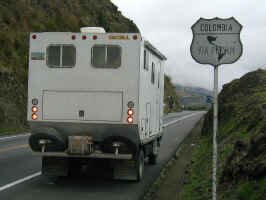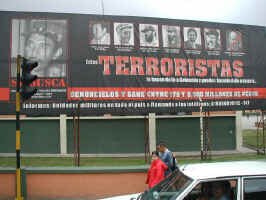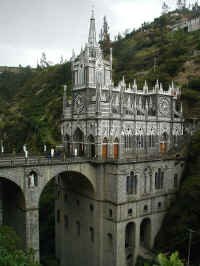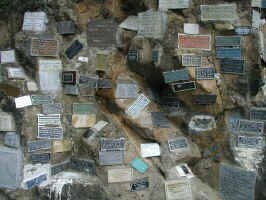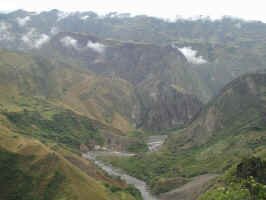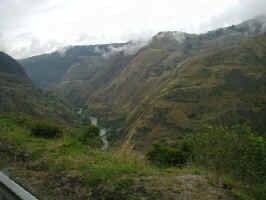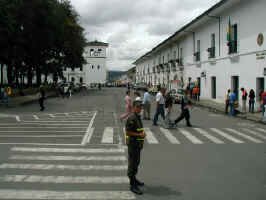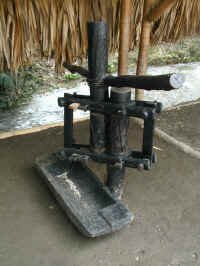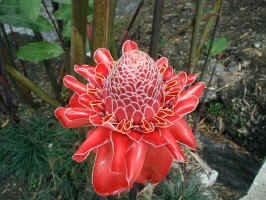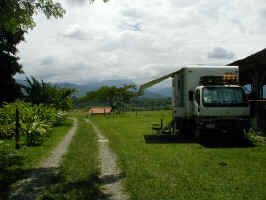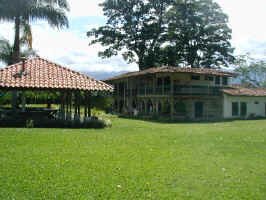October 30 - November 5, 2006 Welcome to Colombia
| We then parked under the sign that read "Colombia" and walked over to immigration to have our passports stamped into the country. We didn't even have to fill out a visitor's card. Then we went to Aduanas to get our Colombian vehicle permit. Our border experiences have led us to feel that the way we are treated at the border will pretty much indicate how we will be treated by officials throughout the country. The border guys here were extremely friendly and welcoming, and completed our paperwork in less than 30 minutes. Very positive. We are looking forward to traveling through Colombia. |
|
We headed into the first city, Ipiales, to get some cash at an ATM. While waiting to turn at a traffic light we spotted a really unusual billboard. This one had photographs of the leaders of the guerrillas who are trying to replace the elected government with a communist-based leadership. They also use money from the sale of cocaine to finance their revolution. |
Well, we had to drive into the central part of the city which is always a bit scary. I dropped Kim off at the bank and was waiting out front. About 5 minutes later a police office told me to move. I figured it shouldn't be too hard to drive around the block - boy, was I wrong.
As I made my way around the streets, one of my turns got me onto a narrow street where I realized, too late, that the end of the street was blocked by a large truck. After trying to get around it and realizing that the Fuso would end up scraping against the buildings, I got out and had to get the half dozen vehicles behind me to move so that I could back up all the way down the street. After what seemed like forever (although only about 15 minutes) I got backed up and on my way. Kim meanwhile, had seen me drive away and knew I'd be back, although she expected me to be a bit quicker than I was. I picked up Kim and we headed down streets barely wider than the Fuso until we crossed the town.
We then headed to the very interesting Santuario de Las Lajas. About 250 years ago an image of the Virgin Mary was believed to have been seen emerging from a rock shelter. A series of churches were then built on the site, culminating in a new-Gothic church built on a stone bridge spanning a river gorge. Like many of the other religious and quasi-religious sites that we have visited in South America, pilgrims come to ask the image of the Virgin (now painted on the rocks inside the church) for a miracle or other help. Plaques from the faithful have been attached to the walls of the canyon giving thanks for answered prayers.
In the morning we hit the highway, actually the Panamericana, as we headed towards the city of Popayan. Our guidebook referred to this drive as beautiful, but also warned that it was a potentially dangerous road due to guerilla activity. We found a high police presence with many checkpoints. The only reason we could find for the road to be dangerous was that it was a curvy, two lane road with many crazy drivers. Oh yes, it was very beautiful - it also took us 8 hours to drive 120 miles, and this on paved roads!
We ended our day with a visit to the Museum of Natural History. It is located in one of the University buildings that also happens to be filled with classrooms. Spread over three stories, the museum is filled with collections of insects and butterflies, mammals and, our favorite, birds. There were hundreds of preserved birds - it was surprising to see just how many birds we have seen during our exploration of South America. We also found that the bird we saw last week in the Amazon, that we had named the "orange screamer" is actually called a Bruja (witch) falcon.
We spent the night in a truck stop north of Popayan. After being a little apprehensive since there was little lighting, we met the owner of the stop and his security guard, who assured us that the truck stop was a busy and safe place to spend the night. True to their word, we spent a peaceful night and awoke to the sounds of turkeys gobbling and peacocks screaming. Yes, for some reason in this remote spot, the owner decided he wanted to keep peacocks.
After a short drive in the morning, we stopped in a town off the highway to stock up on groceries. We then wanted to stop at a sugar cane plantation that has been turned into a museum. Surprisingly we found the museum without trying, because we ended up back on the Panamericana without realizing it. Sometimes things work out, even when you aren't even trying.
We drove down the road to the museum and had lunch before starting our self-tour. We thoroughly enjoyed our walk around the grounds viewing all the old sugar cane presses and enjoying the beautiful plants and birds. At the end of the tour around the grounds there was the old hacienda homestead to admire and we enjoyed our visit.
After driving for a couple more hours, we decided to find a place to stop early and relax. Easier said that done. After stopping a couple of times and deciding against staying for the night, we came across the Parador Rojo, a restaurant built in an area between the north and southbound lanes of the Panamericana. But not only did this restaurant have a large parking area, they had a separate park full of trees and grass with its own parking area, set away from everything else. We asked for and received permission to park for the night then set up our chairs and barbecue pretty much out of view of everyone and enjoyed the trees, the birds and the relative quiet.
The next morning we drove into the town of Armenia to check out the website of Hacienda Bambusa which was recommended by several overlanders. We needed directions to find the Hacienda as it is considerably out of town. After printing out the directions, we headed back south to the turnoff to the airport. We continued on our way believing that we were following the directions correctly. After following along for a while, we realized that we must have made a wrong turn somewhere. We went back a few kilometers and took a roundabout around the airport that took us to a road along the runway. OK, now were back on track. Uh oh, something still doesn't seem to be right.
After a several minutes of trying to find our way, we decided to follow the other directions for travelers coming from Bogota. We found the correct turnoff and followed the road for the correct amount of distance, but when we reached the landmark we were looking for (a gate), we were directed to continue following the paved road to a "T" intersection. Within a short distance, the paved road disappeared and no "T" appeared. We asked several people for help, but no one was familiar with the Hacienda. OK now what? We stopped to have lunch as it had gotten to be quite late while we were looking for Bambusa, and talked about our options. We decided to go back to the gate and ask once again for directions.
Stopping at the gate, the guard told us that he saw us go by and tried to flag us down. He said, "everybody drives right by." Well, it might be because the directions tell everyone to continue on the paved road! Anyway, we followed the verbal directions of the guard and drove through acres of banana fields, finally arriving at the "oasis" called Hacienda Bambusa. It is a gorgeous old building that has been renovated and turned into a hotel, set on beautiful grounds that include a swimming pool and soccer field. The proprietor, Santiago and his father Diego made us feel very welcome. We spent 2-1/2 days there just relaxing, taking walks and birdwatching. The birds are amazing and we lost count of how many different kinds we saw, but a good guess would be between 20 and 30.
